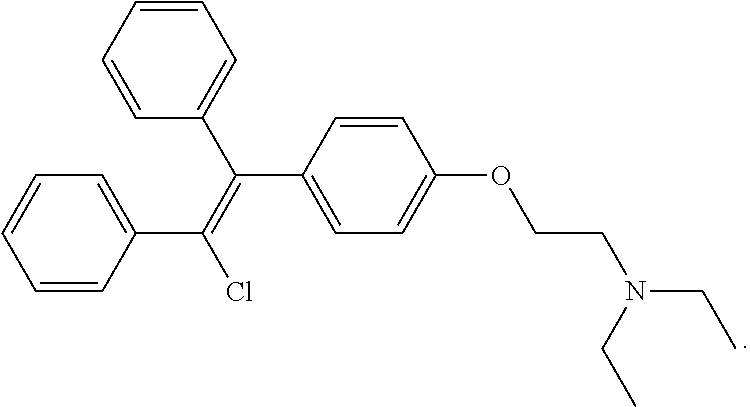Compositions and methods for treatment of filovirus-mediated diseases
a technology of filovirus and composition, applied in the field of composition and methods can solve the problems of no known antiviral therapy effective for treating filovirus-mediated diseases, filoviruses pose serious unmet health and bioterrorism concerns, and viruses are major health problems worldwide, so as to achieve less toxic, convenient treatment, and the effect of reducing the risk of infection
- Summary
- Abstract
- Description
- Claims
- Application Information
AI Technical Summary
Benefits of technology
Problems solved by technology
Method used
Image
Examples
example 1
Identification of Single Therapeutic Agents using a Genetically Engineered Fully Infectious Ebola Virus
[0254]A genetically engineered Ebolavirus (EBOV) expressing the green fluorescent protein (GFP) has been used to develop a high throughput assay for drug discovery (Towner et al., Virology, 332: 20 (2005)). The genetically engineered virus has the unique property of making infected cells glow fluorescent green. The green signal can be detected by fluorescence microscopy, flow cytometry, or fluorometry, and other types of fluorescence detection systems adapted for high-throughput format. In order to perform the assay, seed Vero or HepG2 cells on a 96-well plate at 40,000 cells / well in a total volume of 100 μL / well. The plated cells are incubated cells at 37° C., 5% CO2 until they achieve a stationary growth phase. Next 50 μl of pre-diluted compounds are added at a 4× concentration to each well to achieve the desired final concentration. Finally, 50 μl of GFP-EBOV (multiplicity of in...
example 2
Identification of Synergistic Combination Therapies using the Ebola Replicon Assay
[0260]The screening method described in Example 1 was used to identify combinations of agents that synergistically inhibit viral replication. For each combination of agents, a synergy score was calculated by the formula S=log fX log fY Σ Idata (Idata−ILoewe), summed over all non-single-agent concentration pairs, and where log fX,Y are the natural logarithm of the dilution factors used for each single agent. This effectively calculates a volume between the measured and Loewe additive response surfaces, weighted towards high inhibition and corrected for varying dilution factors. In general, the magnitude of the synergy score indicates the strength of the synergistic interaction. For the Ebola screening described in Example 2, synergy scores >1.0 indicate a synergistic effect of Agent 1 and Agent 2 and synergy scores between 0.3 and 1.0 indicate an additive effect of Agent 1 and Agent 2.
[0261]Potency shif...
example 3
In Vivo Efficacy of Single Agents in a Mouse Model of Ebola Infection
[0263]A mouse model of Ebola infection developed by Bray et al. (J. Infect. Dis., 179:5248-58 (1999)) was used to show in vivo efficacy of single agents. C57BL / 6 mice (n=10 mice per group) were challenged with 100 pfu of a mouse adapted Ebola virus by IP injection. One hour after challenge, the animals were treated with the single agents in Table 9 at the indicated dose and frequency for a total of 10 days. Animals were monitored for survival for a total of 28 days following infection and the mean time to death determined for all cases where there was a sufficient number of non-survivors. In cases where all animals survived, the mean time to death was not determined and is greater than 28 days.
[0264]
TABLE 9DosingSurvivalCompoundStudyDosefrequencyday 28MTDClomiphene160 mg / kgQID90%12.00citrateClomiphene260 mg / kgQID100%—citrateClomiphene360 mg / kgQID male60%9.83citrateClomiphene360 mg / kgQID female70%9.00citrateToremife...
PUM
| Property | Measurement | Unit |
|---|---|---|
| total volume | aaaaa | aaaaa |
| mean time | aaaaa | aaaaa |
| mean time to death | aaaaa | aaaaa |
Abstract
Description
Claims
Application Information
 Login to View More
Login to View More - R&D
- Intellectual Property
- Life Sciences
- Materials
- Tech Scout
- Unparalleled Data Quality
- Higher Quality Content
- 60% Fewer Hallucinations
Browse by: Latest US Patents, China's latest patents, Technical Efficacy Thesaurus, Application Domain, Technology Topic, Popular Technical Reports.
© 2025 PatSnap. All rights reserved.Legal|Privacy policy|Modern Slavery Act Transparency Statement|Sitemap|About US| Contact US: help@patsnap.com



